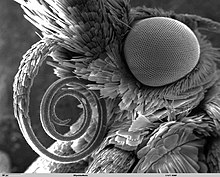Proboscis (butterfly)


The proboscis is most butterflies to receive their food. In almost all butterfly species, this consists of flower nectar , plant juices and other nutrient-rich liquids. Very few species feed on other fluids, such as B. blood , tear fluid or animal excrement and urine . On hot days, butterflies also like to suck water from small puddles. But they also do this to absorb mineral salts .
The proboscis consists of parts of the greatly elongated galeae (parts of the lower jaw). This forms two flexible half-tubes that are connected to one another. This creates the trunk-shaped suction tube between the two tubes. This proboscis is rolled up spirally under the head in the rest position. The butterfly's trunk is probably rolled out by a hydraulic mechanism, whereby the blood pressure is increased inside the half-tubes.
These half-tubes are not connected to each other when the butterfly hatches. They must first be arranged by rolling them in and out several times so that they are parallel to one another and then stick to one another due to a liquid. Structures then get caught on their surface in such a way that the two tubes remain irreversibly connected to the trunk.
Swarmers (Sphingidae) usually have long proboscis and are therefore sometimes specialized in certain flowers. In a hawk species ( Amphimoea walkeri ) living in the subtropics of Central and South America, the trunk length is 280 millimeters; So far no other butterfly species has been discovered that exceeds this length.
A prominent example is also the enthusiast Xanthopan morganii praedicta . When Charles Darwin saw the flower of the orchid Angraecum sesquipedale from Madagascar with its thin, up to 28 cm long calyxes in 1862 , he predicted that there must be an insect that pollinates this flower. This prediction (prediction) by Darwin, who never saw the moth, was confirmed in 1903 when the said hawkmoth with its up to 25 cm long trunk was discovered. That is why he was called praedicta , meaning “the predicted”.
The investigation of the proboscis in butterflies revealed astonishing examples of evolutionary adaptations to different liquid foods (e.g. nectar, fruit juices, tree saps, feces) as well as adaptations to the use of pollen as additional food in Heliconius species, a group of Neotropical butterflies . An extremely long proboscis occurs within different groups of flower visitors, but is relatively rare.
See also
Individual evidence
- ^ Roger Philips, David Carter: Kosmos Atlas Butterfly Guide, European Day and Night Moths. Franckh-Kosmos Verlag, Stuttgart 1991, ISBN 3-440-06306-2 .
- ^ A b H. W. Krenn : Feeding mechanisms of adult Lepidoptera: structure, function, and evolution of the mouthparts. In: Annual Review of Entomology. 55, 2010, pp. 307-327.
- ↑ idw-online.de
- ↑ amnh.org ( Memento from July 16, 2012 in the Internet Archive )
- ↑ HW Krenn, KP Zulka, T. Gatschnegg: Proboscis morphology and food preferences in Nymphalidae (Lepidoptera, Papilionoidea). In: Journal of Zoology. London 253, 2001, pp. 17-26.
- ↑ MCN Knopp, HW Krenn: Efficiency of fruit juice feeding in Morpho peleides (Nymphalidae, Lepidoptera). In: Journal of Insect Behavior. 16, 2003, pp. 67-77.
- ^ HW Krenn, MJB Eberhard, SH Eberhard, AL. Hikl, W. Huber, LE Gilbert: Mechanical damage to pollen aids nutrient acquisition in Heliconius butterflies (Nymphalidae) In: Arthopod-Plant Interactions. 3/4, 2009, pp. 203-208.
- ↑ AL. Hikl, HW Krenn: Pollen processing behavior of Heliconius butterflies: A derived grooming behavior. In: Journal of Insect Science. 11, 2011, Article 95, available online: insectscience.org/11.95.
- ↑ J. Bauder, N. Lieskonig, HW Krenn: The extremely long-tongued Neotropical butterfly Eurybia lycisca (Riodinidae): Proboscis morphology and flower handling. In: Arthropod Structure & Development. 40, 2011, pp. 122-127.